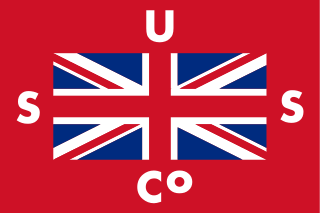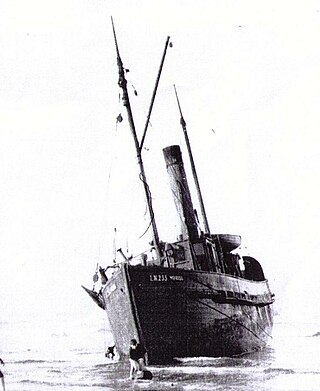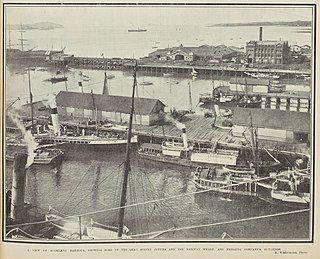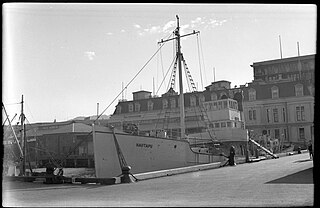Related Research Articles

Viaduct Harbour, formerly known as Viaduct Basin, is a former commercial harbour on the Auckland waterfront that has been turned into a development of mostly upscale apartments, office space and restaurants. It is located on the site of a formerly run-down area of the Freemans Bay / Auckland CBD waterfront in Auckland, New Zealand. As a centre of activity of the 2000 America's Cup hosted by the Royal New Zealand Yacht Squadron, as well as the 2022 Rally New Zealand, the precinct enjoyed considerable popularity with locals and foreign visitors.

Union Steam Ship Company of New Zealand Limited was once the biggest shipping line in the southern hemisphere and New Zealand's largest private-sector employer. It was incorporated by James Mills in Dunedin in 1875 with the backing of a Scottish shipbuilder, Peter Denny. Bought by shipping giant P&O around the time of World War I it was sold in 1972 to an Australasian consortium and closed at the end of the twentieth century.

Muriel was a New Zealand fishing trawler that was built in 1907 by Messrs Lane & Sons of Totara North. In 1937, Muriel stranded on Sumner Bar at Christchurch, New Zealand, and was a total loss.

The Northern Steam Ship Company Ltd (NSS) served the northern half of the North Island of New Zealand from 1881 to 1974. Its headquarters, the Northern Steam Ship Company Building, remains in use on Quay Street, Auckland as a bar and is listed by Heritage New Zealand as a Category I Historic Place.
Novelty was a barque-rigged iron paddle steamer, built at Sydney in 1863.

Mullogh was a ketch rigged steam ship, built in 1855 in Belfast. It sailed to Australia, then to New Zealand. The wreck of Mullogh is now beached on Quail Island.
Torrington was a brig built in 1847. It sank in New Zealand in 1851.
William and John was a New Zealand cutter of 10 tons.

Darra was a barque-rigged clipper, built at Aberdeen and launched in 1865.

SS Hilonian was a general passenger and cargo steamer, built as the Triumph in 1880 at Middlesbrough for McIntyre & Co, and later fitted with refrigeration equipment and leased to Shaw Savill and the New Zealand Shipping Company. She sank and ran aground many times, the final sinking being by torpedo in 1917.

SS Rotomahana was an 1876 harbour steamer and the first iron vessel to be built in Auckland, though launched only 28 minutes ahead of another, though smaller, iron ship. Rotomahana was a name used by at least two other ships of the era, presumably because Rotomahana and its Pink and White Terraces had become better known after the Duke of Edinburgh visited in 1870.

SS Go Ahead was a twin screw-steamer, launched on the afternoon of Saturday 20 April 1867 by Seath and Connell, of Rutherglen, for the Clyde Shipping Company, with a plan to use her in New Zealand coastal trading. She had 30, or 35 hp (26 kW), high pressure engines, and tubular boilers from Campbell & Son's foundry.
Dolphin was a New Zealand cutter of 10 tons.

George Holdship (1839–1923) emigrated to Auckland in 1855 and became a businessman, mainly involved in timber logging and sawmills. His companies removed much of North Island’s native forest, initially kauri and later kahikatea. He moved to Sydney in 1913.

The Anchor Shipping and Foundry Company linked Nelson with other parts of New Zealand from 1870 to 1974. The company's former office remains on the quay at Nelson, as do steps of their foundry, which built one of their ships, repaired their fleet and made other machinery.
Awarua Rock is an unofficial name for an island on the coast of New Zealand's Northland Region. It is located on the Pacific coast, north of the entrance to Whangārei Harbour.

HMNZS Hautapu was one of eight steel New Zealand-built Castle-class trawlers built and commissioned by the Royal New Zealand Navy during World War II.

SS Wiltshire was a passenger ship built for the Federal Steam Navigation Company by John Brown's of Clydebank in 1912 to run between Britain, Australia and New Zealand. She was wrecked when she ran aground in 1922.

SS James Cosgrove was a Castle-class trawler built for the United Kingdom for use as a minesweeper. She was purchased by Sanford Ltd in 1920 for use in New Zealand as a fishing trawler, being used as a minesweeper again during World War II. She was scrapped at the Western Viaduct in the 1950s, with her hulk being sunk in 1952.

Minerva was a 21-ton, kauri-built, steam passenger ferry, launched for Clevedon Steam Navigation Company Limited at the Freemans Bay yard of Charles Bailey on 10 December 1910, to link Auckland with Whitford and Howick. A social for the new ship was held at Whitford on 16 January 1911.
References
- 1 2 Ingram, C.W.; Wheatley, P.O.; Diggle, L; Diggle, E; Gordon, K (2007). New Zealand Shipwrecks. Auckland: Hodder Moa. pp. 427–428. ISBN 978-1-86971-093-4.
- ↑ "AUCKLAND STAR". Vol. L, no. 50. 27 February 1919. Retrieved 6 April 2020.
- ↑ "CHRISTCHURCH STAR, ISSUE 12723, 19 AUGUST 1919". paperspast.natlib.govt.nz. Retrieved 6 April 2020.
- ↑ "AUCKLAND STAR, VOLUME LII, ISSUE 163, 11 JULY 1921". paperspast.natlib.govt.nz. Retrieved 6 April 2020.
- ↑ "NEW ZEALAND HERALD, VOLUME LIX, ISSUE 18135, 6 JULY 1922". paperspast.natlib.govt.nz. Retrieved 6 April 2020.
- ↑ "OTAGO DAILY TIMES, ISSUE 21036, 27 MAY 1930". paperspast.natlib.govt.nz. Retrieved 6 April 2020.
- ↑ "EVENING STAR, ISSUE 20119, 8 MARCH 1929". paperspast.natlib.govt.nz. Retrieved 6 April 2020.
- ↑ Locker-Lampson, S; Francis, J (1994). Rediscovered New Zealand Shipwrecks: The Wreck Book. Auckland: The Halcyon Press. pp. 28–29. ISBN 0-908685-82-3.